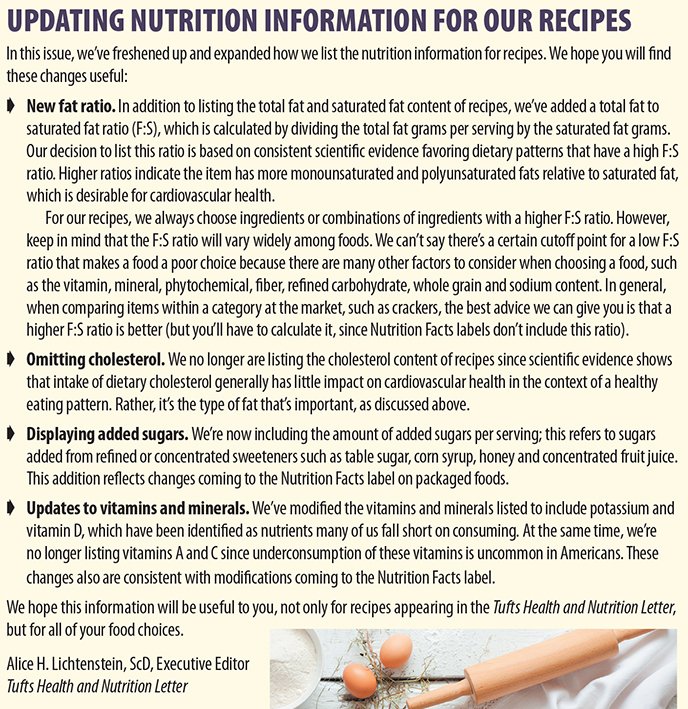Dreamstime.com

Not only can substitution save the day when you lack an ingredient called for in a recipe, but it also enables you to make a recipe better for you. That’s helpful whether you are trying to improve your overall eating pattern or are cooking for a specific health condition.
Although you may hesitate to change a recipe for fear of ruining it, remember that recipes are simply instructions for combining and processing a group of ingredients. “Recipes are crafted by people who simply had ideas about what ingredients may work together, but there’s no reason you can’t change them,” says Helen Rasmussen, PhD, RD, an instructor at Tufts’ Friedman School and a senior research dietitian in the Metabolic Research Unit at the HNRCA. “You’ve probably found that even some published recipes don’t taste quite right when you first make them, so you make notes and tweak them next time to get a better result.” Substituting ingredients to improve healthfulness of recipes works the same way.
Healthy Food Substitutions
There are almost countless ways you can modify recipes and simple dishes to make them more healthful. Here are a few to consider. When you modify
a recipe, you can analyze the nutrition content at sites such as the USDA’s SuperTracker.
Try using 1 cup stick margarine with 0g trans fat or 7/8 cup vegetable oil*instead of 1 cup traditional stick mangarine containing trans fat or butter
Try 1 cup shortening with 0g trans fat or 1 cup vegetable oil instead of shortening containing trans fat or lard
Try 1 cup nonfat or low-fat plain Greek yogurt instead of 1 cup cream cheese
Try 1 cup low-fat or nonfat plain yogurt (regular or Greek) instead of 1 cup sour cream
Try 2/3 cup sugar instead of 1 cup sugar
Try 1/4 cup pureed fruit, such as applesauce instead of 1/4 cup maple syrup
Try 1 cup all-purpose flour and 1 cup whole-wheat flour instead of 2 cups all-purpose flour
Try 1 cup whole-wheat pastry flour instead of 1 cup all-purpose flour
Try 1 cup graham flour plus 1 tbsp. wheat gluten instead of 1 cup bread flour (refined)
Try 1 cup uncooked brown rice, quinoa, barley or amaranth (check cooking times) instead of 1 cup uncooked white rice
Try 3/4 dried lentils or 2.25 cups cooked lentils (or other legumes) instead of 1 lb. ground meat
Try 1 lb. crumbled, marinated tempeh instead of 1 lb. crumbled sausage
Try 1/2 cup no-salt-added or reduced-sodium tomato sauce plus 1/2 cup water instead of 1 cup tomato juice
Note: lb. = pound, tsp = teaspoon, Tbsp = tablespoon
*Replacing solid fat with oil doesn’t work in all baking recipes; it works better in recipes that require melting the solid fat first. You may need to add salt to a recipe if it calls for salted butter (or margarine) and you replace it with oil.
Consider What to Change:
Swapping ingredients for health reasons should start with your goal(s) in mind. Perhaps you’re trying to cut back on salt, increase fiber or boost nutrition. “If you are the chef in your household, think about how you might substitute an ingredient in your dish that is nutritionally superior to what was in the original recipe,” says Nicola McKeown, PhD, a scientist in the Nutritional Epidemiology Program at the HNRCA. For example, replacing regular sour cream with low-fat Greek yogurt provides four times as much protein and reduces calories by more than half. Reviewing such products’ nutrition labels side by side will show you how they compare.
Besides replacing ingredients in a recipe, you might simply reduce the amount of less healthful ingredients, such as salt or sugar. Many recipes can accommodate such reductions, but realize that some ingredients are key to the performance of certain recipes. For example, although you can reduce the salt in a soup or salad dressing recipe, a certain amount of salt is essential in yeast bread. If you omit salt in a yeast bread recipe, not only will the flavor be bland, but the gluten needed to form the bread structure will be weaker, resulting in a flatter loaf.
Similarly, although you often can reduce the sugar in recipes (such as by to ⅓ in baked goods) and never miss it, you probably won’t be able to eliminate it entirely. Sugar helps make baked goods, such as quick breads and muffins, more moist and tender, plus aids in browning. In yeast bread, a bit of sugar supports fermentation.
So, take a careful look at recipes and see what healthful tweaks make sense for the recipe and for your palate. Here we review some changes you might make and why they may benefit your health.
Why and When to Substitute Fats:
Recipe substitution guidelines and cookbooks that were popular in the 1990s focused a lot on cutting out fat. However, scientific evidence shows that cutting out fat isn’t the goal – about a third of our calories should come from fat. With that said, the type of fat is key: we should strive to replace less healthful fats with more healthful ones.
“The best data we have to date suggest there’s an advantage for cardiovascular health when animal fats, which are rich in saturated fat, are replaced with vegetable oils high in polyunsaturated and monounsaturated fats,” says Alice H. Lichtenstein, DSc, director of Tufts’ HNRCA Cardiovascular Nutrition Laboratory. According to the 2015-2020 Dietary Guidelines for Americans, which Lichtenstein helped inform, strong and consistent evidence shows that replacing saturated fats with unsaturated fats, especially polyunsaturated fats (which are present in high amounts in corn oil and soybean oil), is associated with lower blood levels of total cholesterol and LDL (bad) cholesterol and lower risk of heart attacks and cardiovascular-related deaths. Some evidence suggests replacing saturated fat with monounsaturated fat, which is found in higher proportions in canola oil and olive oil, also benefits cardiovascular health, but the evidence isn’t as strong as for polyunsaturated fat.
“People also should note that we’re not encouraging them to replace saturated fat with carbohydrate, particularly refined carbohydrate such as white flour and sugar,” Lichtenstein says. Although replacing saturated fat with carbohydrate may reduce blood levels of total and LDL cholesterol, which is desirable, this substitution also increases blood levels of triglycerides and reduces HDL (good) cholesterol, which is not desirable.
So, for example, although it was common in the past to advise replacing the fat or oil in a baked good with pured fruit, a better choice is to replace a highly saturated fat, such as butter or lard, with a vegetable oil. To learn more about assessing the fat content of a recipe, see “Updating Nutrition Information for Our Recipes,” below.
How to Substitute Fats:
When a recipe calls for a solid fat, such as butter, shortening or margarine, can you just swap in vegetable oil? It depends what the recipe is. “If the recipe instructs you to melt a fat (such as butter), it generally works fine to substitute oil,” Lichtenstein says. Or, if you’re sauting something in the fat, the type of fat shouldn’t make much difference, as long as it’s one that tolerates the heat of cooking without starting to burn. Common vegetable oils, which are typically refined, can be heated to higher temperatures (around 450 degrees Fahrenheit) while most unrefined oils, such as many specialty nut and seed oils, can’t be heated very high (generally 225 to 320 degrees Fahrenheit), so they’re better used for drizzling, salad dressings and marinades. Extra-virgin olive oil can be heated to 410 degrees Fahrenheit.
When a recipe for a baked good calls for a solid fat, it’s preferable from a health standpoint to use oil instead of butter, lard or vegetable shortening and traditional stick margarines that contain trans fat (partially hydrogenated oil). However, for some baked products, solid fats are preferable due to their textural characteristics. In such cases, use shortening or margarine with 0 grams trans fat, which have become widely available as man-made trans fat is being phased out. Spreads that are less than 60% oil generally won’t work well in baked goods since these spreads are higher in water. That could negatively impact the structure and texture of the baked good, as well as decrease browning.
Substituting Leaner Proteins:
Two ways to improve the fat profile of meat-based recipes, particularly to reduce saturated fat, are to use leaner meat and reduce the meat portion. The words “loin” and “round” are clues (in addition to appearance) that a cut of meat is leaner. Examples are round steak and pork tenderloin. If a nutrition label is available, note that lean meats and poultry are those with less than 10 grams of fat and 4.5 grams or less saturated fat per labeled serving size (and per 100 grams of meat).
If you’ve tried leaner meats, you may have found that they were drier since they had less fat. That can be overcome with how you cook such meats. “Using a moist-heat cooking method helps prevent leaner meats from getting tough or dry,” Rasmussen says. “Examples of that are simmering or braising the meat in a sauce or other liquid. A slow cooker also works well for making fork-tender meat, plus you can add herbs and spices for flavor without them falling off as they might if you were grilling the meat.”
If a recipe will accommodate changing the protein source entirely, you can swap skinless chicken or fish for the meat, either of which will lower the saturated fat content. For example, instead of making tacos with ground beef, try a baked white fish or ground chicken or turkey sauted with herbs and spices as the “meat” in your taco.
For some recipes, you can make them meatless by using lentils, black beans, tofu or tempeh in place of meat. For example, use beans to replace some or all of the animal protein in recipes like chili, sloppy Joes, burgers, meatloaf and meat sauces. Not only will that reduce saturated fat, but it also will add fiber.
Substituting Whole Grains:
As you’re likely aware, you can replace refined grains, such as all-purpose flour and white rice, with whole grains, such as whole-wheat flour and brown rice, respectively. Swapping whole grains for refined grains can increase certain nutrient levels of a recipe.
For example, when whole-grain wheat is refined, its bran and germ are removed, resulting in nutrient losses. The FDA requires iron, thiamin, riboflavin, niacin and folic acid to be added to enriched grains, but there are other losses in the refining process. According to USDA nutrition data, refined wheat flour contains only 26% of the fiber, 17% of the magnesium, 30% of the potassium, 28% of the zinc and 11% of the vitamin B6 found in whole-wheat flour.
To illustrate the implications of this, current intake of dietary fiber among Americans is low. In fact, the Scientific Report of the 2015 Dietary Guidelines Advisory Committee stated that among older adults, only 4 percent of men and 13 percent of women had adequate dietary fiber intake. On average, adults should aim for 28 grams fiber daily. “Replacing refined grains with fiber-rich whole grains, such as whole wheat, rye or barley, is an easy way to work toward your daily fiber goal,” McKeown says. “Be a bit more adventurous and try whole grains such as quinoa, teff and ancient forms of wheat like kamut or farro, too,” McKeown says.
How to Substitute Flour:
If you do any baking, swapping whole-grain flour for refined flour (all-purpose flour), is wise. “When you exchange whole-wheat flour for all-purpose flour, make a gradual shift,” Lichtenstein says. “For example, if you’re making cookies or a quick bread, such as pumpkin bread or banana bread, start by replacing half of the refined flour with whole-wheat flour. If that goes well, which it most likely will, make it whole-wheat flour the next time, and finally, try replacing the full amount. The finished product may be a little heavier, but probably not much, and will have a more complex flavor.”
For baking whole-wheat yeast bread, Lichtenstein prefers graham flour (whole grain), which is more coarsely ground, and adds wheat gluten to improve the texture and elasticity of the dough. Making yeast bread is a bit of an art, since you need to make it to a certain consistency, but certain tips help. The bran in whole-wheat flour soaks up more liquid, so you either have to add a little more liquid or use a little less flour, Lichtenstein says. It also helps to let the dough rest about 20 to 30 minutes before kneading (to give the flour a chance to absorb the liquid and for the gluten to form). Use well-oiled hands to knead the dough, so you aren’t tempted to add too much flour to prevent sticking.
If you prefer a milder flavor in baked goods, try white-whole wheat flour (which is made from hard white wheat) and whole-wheat pastry flour (which is made from soft white wheat). Don’t let the word “white” fool you. These are still whole-grain flours, but instead of being made from red wheat, as the majority of flour in the US is, they’re made from white wheat, which is simply a different strain of wheat. It’s called white because unlike red wheat, the bran in white wheat is lighter in color, yet it’s considered nutritionally equivalent to traditional (red) whole wheat.
White-whole wheat flour works well as a substitute for all-purpose flour in most baking. Whole-wheat pastry flour is lower in protein, resulting in baked goods with a lighter, more tender texture; try it in muffins, pancakes, pie crust and quick breads (but not yeast bread).
How to Substitute Intact Grains:
Swapping one intact (not ground) grain for another may seem more straightforward than trading one type of flour for another, but you still need to know how much the dry grain yields when cooked, compared to another. To find out this information, check packages. For example, although 1 cup uncooked brown rice and 1 cup uncooked quinoa both yield 3 cups when cooked, 1 cup uncooked wheat berries yields 2 cups.
When substituting intact grains, you also should check differences in cooking times. For example, if you want to use traditional brown rice in place of white rice in porcupine meatballs that cook in 25 minutes, you’ll have to start with partially-cooked brown rice or increase the cooking time since brown rice can take up to 45 minutes to cook. On the other hand, since quinoa takes only 12 to 15 minutes to cook, it would be an easy swap for white rice in the meatballs.
Get Feedback:
“Collaborating in recipe modification is like magic,” Rasmussen says. “Once people taste something, they can come up with suggestions for substituting or adding other ingredients that you might not have thought about.” That helps take a recipe from good to great.
Lastly, don’t let the guidelines for modifying recipes hold you back. “Ultimately, you won’t know if a substitution will work in a particular recipe unless you try it,” Rasmussen says. So, go for it!
To learn more:2015-2020 Dietary Guidelines for Americans
To learn more:Nutrition Today, May/June 2016

























